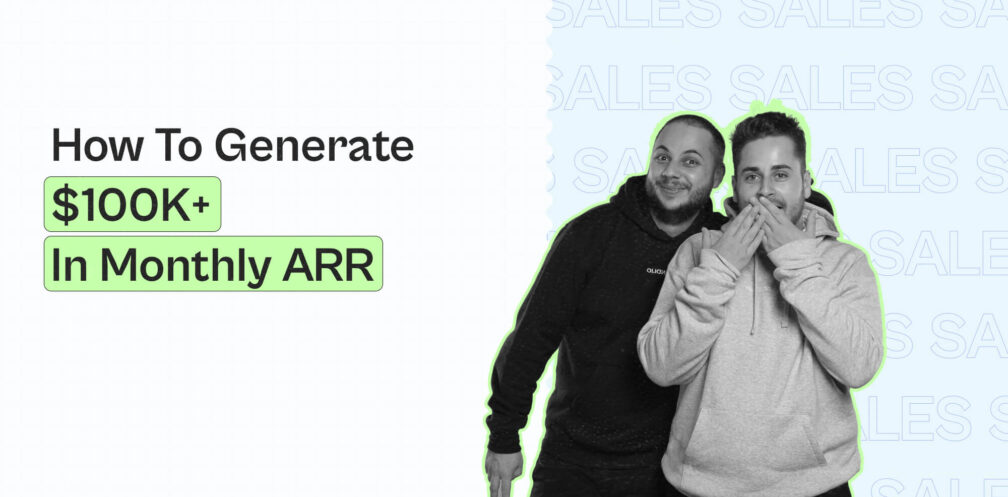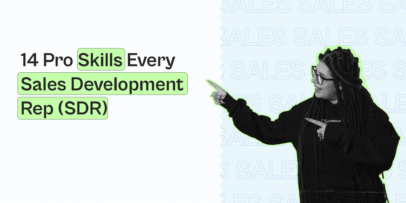How to Generate $100k+ in Monthly ARR [the secret to hacking a high ticket sales funnel]

The phrase “closing high-ticket sales” may be causing you cold feet.
The constant what-ifs hold many agencies from exploring the biggest revenue-generating system – a high-ticket sales funnel.
Don’t worry — this guide will show you the exact roadmap you can follow to bag high-ticket deals and generate a consistent revenue stream for your agency.
What are high ticket sales?
High-ticket sales are products or services with premium pricing that allow businesses to generate substantial revenue and gain higher profit margins.
For example, a typical agency can price a “high-ticket” item for $1000+ and offer sufficient value for the customer purchasing it.
A funnel makes this feasible.
A high-ticket sales funnel is an automated system to attract, nurture, and convert customers for such sales.
A high-ticket funnel can have multiple advantages, such as:
- Boost the brand’s impression of exclusivity and authority in the niche
- Opportunities for upselling and cross-selling products or services
- Lower overhead costs and spending
- A consistent and promising revenue stream
A quick overview of our high-ticket sales funnel
Here’s what you’ll be doing:
- Building a list of dream clients that are most likely to use your high-ticket item
- Putting them in the spotlight. For example, inviting them to your podcast or a catch-up
- Creating content with them and distributing it on socials to position yourself as the thought leader on the topic
- Building a genuine connection with these potential customers
- Successfully closing them as clients
Why this plan works:
1. Jumping in and trying to close high-ticket deals with new potential customers is never the right strategy. Our plan works by nurturing a real connection with your dream clients, establishing trust, and, eventually, tailoring the solution to match their needs.
2. You and your prospect can create a lot of content around relevant topics, thus establishing yourselves as the thought leaders in the niche.
Let’s decode these steps.
Making a list of your dream clients to be part of your high-ticket sales funnel
Remember, quality is better than quantity in this step. So, the idea is to have about 100 to 200 people who:
- Need your high-value product
- Have money to pay you
- Match your agency’s target ICP
- You can use to create insightful case studies on
- Are big names in your target industry
Values to include in your list
Your “dream client” list must contain:
- Prospect first name
- Last name
- Company name
- Company website
- Prospect LinkedIn profile
- An icebreaker – this needs some homework. It’s a personalized line or two telling the prospect why they should be on the podcast or chat.
Here are our sample “icebreakers” created using ChatGPT for LinkedIn outreach:
Why a podcast?
Move over boring webinars. Podcasts are the best excuse to build real customer connections. They give your dream clients a platform to be themselves and have great two-way conversations.
Another big advantage of podcasts is how easy it is to cut snippets of your discussions and share them as mini content for social media. Such content has greater reach, allowing you to generate a ton of inbound leads.
If you’re new to podcasts and confused about what your initial topics should be, here’s a trick:
- Use topics around customer pain points that your offering solves. This way, it’s easy to sell to your dream clients
- Choose a topic that top decision-makers at your target companies are most likely to discuss
- Look at other podcasts in your niche – what’s missing in them, and how can you stand out?
Once you’ve shortlisted some topics, have some standardized questions ready to go. For example, asking how they retain high-value customers at their company. Such questions will seem interesting to other companies who are bad at customer retention.
Inviting your dream 100 or 200 clients to speak on your podcast
We suggest you take the omnichannel approach via LinkedIn and email to reach out to your prospects. It has the best results in terms of response rates.
Expandi is your best bet to make this happen on auto-pilot.
Here’s the exact flow:
Step 1: Send each prospect a LinkedIn connection request without a message to have more success with acceptance
You don’t have to do this step manually.
Sign up for Expandi’s free trial, and set up a Campaign > Connector campaign where you can just upload the CSV file with prospects’ names and LinkedIn profiles and let Expandi do the outreach for you.
Step 2: If accepted, send them a personalized LinkedIn message with the icebreaker (refer to the previous section), like so:
Hey [first_name],
{Icebreaker – ex: Loving your work at [company_name]. Moved from [competitor_name] to your product last month, and I’m hooked!}
I would like to publish a story about you and [company_name]; I’m soon launching a podcast for [purpose].
Are you in?
Read this guide on setting up a quick LinkedIn message automation in under 5 minutes.
Step 3: Send non-responders an email
Subject line: Podcast invite
Hey [first_name],
I wrote to you on LinkedIn a few days ago, but I didn’t get through. I would like to invite you as a guest to my podcast about [topic].
I know you have plenty of expertise on this topic, and would love to tell your story to inspire others.
The recording will be around an hour or less, and the content will be distributed on 10+ channels.
Let me know if you’re in!
This strategy is a win-win for both you and your clients, with a success rate of about 25% (that’s huge!).
Remember not to be pushy and start selling anything. These steps are just to build a strong relationship with the potential clients.
What to do during the recording
Some things to keep in mind during the recording so your efforts don’t go to waste:
- Build an automated sequence to remind guests about the podcast recording data
Your clients can get busy and forget about the invite. So, preparing them in advance with an automated follow-up sequence is best.
Expandi has a follow-up sequence within its LinkedIn Connector campaign:
Read this guide on creating responsive follow-ups.
- Ensure the conversation is friendly and not one-sided
That means not being authoritative or interrupting guests between answers. These 45 minutes are to establish a one-on-one connection and not sell anything (yet!)
- Identify their problems
If this step is not done well, there is no point in recording a podcast and building a future relationship with each client.
Asking them about their problems before or during the recording may not fetch your desired responses.
So, what can you do instead?
Say you do B2B LinkedIn lead generation for SaaS companies.
You invite a founder to the show, and all he or she talks about is how they use ads and SEO to bring in inbound leads.
You can then pitch in and ask them: “What are your thoughts on outbound lead generation? Have you ever tried LinkedIn?”
As a follow-up, ask them why they never thought of it, or if they did, why they stuck to inbound instead.
That’s about it.
You can catch an underlying problem they may be facing with lead generation. Use this to approach them in the next few days (see below).
Nurture your relationship with your dream clients after the podcast
Your connection should not come to a sudden stop after the podcast. Ensure you maintain it by proper nurturing.
These are the steps you can take:
Step 1: Ship a personalized gift to each prospect within a week of wrapping up the podcast. No matter how small or inexpensive it may be, a thoughtful gift helps you leave a lasting impression.
Step 2: Send them the uploaded podcast details. Once the podcast is live, write a friendly email with relevant links where the client can find it.
Ensure your email contains URLs on every channel it’s been distributed to. For example, share relevant podcast links for Spotify and Apple Podcasts, YouTube Shorts, and other short videos on TikTok or Instagram.
Step 3: Share podcast results. Clients would appreciate their words going viral and receiving likes. It’s the best opportunity to stay in touch with your clients.
Here’s an example email:
Hey [first_name],
Just wanted to drop by and share the amazing results we’ve received on our podcast episode.
It was listened to by 800+ people over just the last week, and the video snippet on LinkedIn got over a thousand views and reactions.
{Images/s}
Thanks again for your time!
Step 4: Engage with their social media content, such as LinkedIn and X posts. Engage only when you have something insightful to add to their post, and don’t comment just for the sake of it.
Step 5: The most important part – offer help. This is where you step in and let prospects know they can hire your agency to solve their problems once and for all.
However, be careful not to hard sell and be overly pushy.
Keep a gap of about a week post-step 3 email to send this LinkedIn message. And don’t forget you’re still offering value:
Hey [First_name],
I was building a LinkedIn outreach lead list for another SaaS company and found these leads match better for [company_name], so I thought I’d send it over.
- [Lead_name] – [Company_name] – [Location] – [Email] / [LinkedIn profile link]
- [Lead_name] – [Company_name] – [Location] – [Email] / [LinkedIn profile link]
- [Lead_name] – [Company_name] – [Location] – [Email] / [LinkedIn profile link]
If you want, I and the folks at [agency_name] can build a similar list of 1000 leads for you. It’s free of charge and a small gesture to say thanks.
[Signature]
People love free stuff, and there’s a high chance you may receive a response. If not, don’t follow up over email or LinkedIn; instead, mention it to them when casually chatting later.
Suppose they respond. They’ll see value in your work and ask you how much your agency charges. Pull up an “exclusive discount” for your good friend, book a demo, and take it from there.
To see amazing results and eventually achieve $100k+ ARR, plan to record at least 4 to 5 podcasts monthly!
High-ticket sales examples of real agencies
Here are two examples of agencies that have created a high-ticket sales funnel and seen outstanding results via the podcast route:
1. Content Kettle – A content marketing agency invites top eCommerce founders to speak on their podcast
Content Kettle is a podcast hosted by Contensify, a top content marketing agency. It offers SEO, content, lead generation, and other solutions.
The podcast aims to speak to top eCommerce founders and leaders about digital marketing, GTM, and more.
It helped Contensify establish itself as a thought leader in eCommerce content, drove significant traffic to their agency website from multiple potential clients, and signed them up as high-ticket customers.
2. Business Made Simple – A coaching agency that made millions in high-ticket sales
This agency interviews startup founders and top marketers weekly. It hits two birds with one stone—it creates a great relationship with the guests while addressing topics their target audience would find helpful.
With multiple high-ticket sales and offers, the coaching agency is a perfect example of how to make a high-ticket sales funnel work despite the competition.
Wrapping up
That was everything you needed to create a breakthrough high-ticket sales funnel. Modify the steps based on your agency’s needs to attract, nurture, and convert high-paying prospects.
With safe outreach automation tools like Expandi by your side, connecting with your dream clients is just a few steps away.
You’ve made it all the way down here, take the final step


